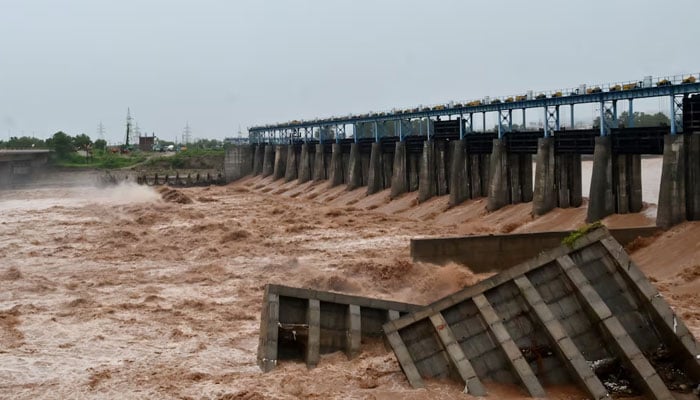- Pakistan, India bound to warn of extraordinary discharges of water.
- Treaty provisions dams’ operations to prevent damage to other party.
- India responsible for failure to share information about Sutlej River.
LAHORE: Pakistan has been grappling with a severe and unprecedented flood situation, amplified by the abrupt water release from Indian dams.
The crisis is compounded by India’s decision to suspend the Indus Waters Treaty (IWT), an accord that has governed shared water resources for over six decades.
As Pakistan battles unprecedented floods, concerns are mounting over India’s refusal to adhere to the IWT, with allegations surfacing that New Delhi has failed to uphold its critical duties regarding timely flood warnings. This comes at a time when the country’s Chenab, Ravi, and Sutlej rivers are experiencing dangerously high flood levels.
Under the 1960 Indus Waters Treaty, both India and Pakistan are bound by specific provisions designed to prevent material damage from water flows.
Article IV-8 explicitly states, “Each Party agrees to communicate to the other Party, as far in advance as practicable, any information it may have in regard to such extraordinary discharges of water from reservoirs and flood flows as may affect the other Party.”
Furthermore, Article IV-9 outlines each party’s intention “to operate its storage dams, barrages and irrigation canals in such manner […] as to avoid, as far as feasible, material damage to the other Party.”
However, India has not consistently met these obligations. For instance, while an alert regarding a potential flood in the Tawi tributary of the Chenab River was reportedly conveyed to Pakistan on Sunday (August 24, 2025), there was a critical failure to share updated information about the Sutlej River.
By the time the Tawi alert was issued, the Sutlej had already reached high flood levels, exceeding 122,000 cusecs, leaving lower riparian South Punjab with insufficient time to prepare for the surging waters.
This alleged lapse in information sharing is particularly alarming given India’s unilateral decision on April 23, 2025, to suspend the Indus Waters Treaty. Soon after holding the IWT in abeyance, India intentionally reduced outflows from the water reservoirs built on the Chenab River to minimum levels, causing a serious water shortage amid high demand for irrigation. In response, Pakistan had to release water from the Mangla Dam to meet the shortfall in the Chenab water.
As previously reported, the unilateral suspension of the IWT by India has halted formal data exchange and cooperative mechanisms, leaving Pakistan with less advance notice to manage its rivers and mitigate the impact of floods.
The confluence of heavy monsoon rains and these unannounced or delayed water releases from Indian dams is exacerbating the country’s water crisis, threatening its agricultural sector, economic stability and water security, and potentially leading to widespread food insecurity and public unrest.
The latest report from the Flood Forecasting Division, issued at 9pm on Wednesday, August 27, paints a grim picture of the situation. The Chenab, Ravi, and Sutlej rivers are experiencing dangerously high flood levels. The Chenab River is at an extremely high flood level at all four of its monitoring sites, with a massive outflow of 1,077,951 cusecs recorded at Qadirabad. Similarly, the Sutlej River is in an exceptionally high flood at Ganda Singh Wala, while the Ravi River is at a high flood at Shahdara.
This devastating flood comes on the heels of India’s announcement in April this year to hold the IWT in abeyance. This unprecedented move has halted the formal sharing of crucial hydrological data and cooperative mechanisms in a meaningful way. Without this critical information, Pakistan is left with less advance warning to manage water flows and mitigate flood risks, which its officials have long relied upon.
An official said the formal flood alert shared by India in the last couple of days was not helpful in taking precautionary measures well in time. It was partly due to the fact that, unlike previous practice, India did not share data on releases from all its water reservoirs on eastern rivers.
In such a situation where outflows from upper riparian are uncertain, the river inflows downstream highlight the precarious water management, underscoring the need for precise coordination and monitoring to mitigate potential flood risks and ensure optimal water utilisation.
While the Indus River at the Tarbela Dam, the Jhelum River at the Mangla Dam and the Kabul River at Nowshera show moderate and stable flows, other key rivers, especially originating from or passing through India, are under immense pressure.
The Chenab River at Marala has high inflows of 769,500 cusecs, with almost equal outflows. Barrages downstream are also managing high flows, including Chashma Barrage (inflows of 305,700 cusecs) and Taunsa Barrage (inflows of 345,200 cusecs).
The ongoing floods threaten to severely impact the country’s already struggling agricultural sector, which is the backbone of its economy. The crisis is a significant risk to the nation’s economic stability and food security, and could lead to public unrest as the humanitarian situation deteriorates. With heavy monsoon rains continuing and the suspension of the IWT’s data-sharing mechanism, Pakistan is facing a severe water crisis.
Originally published in The News


